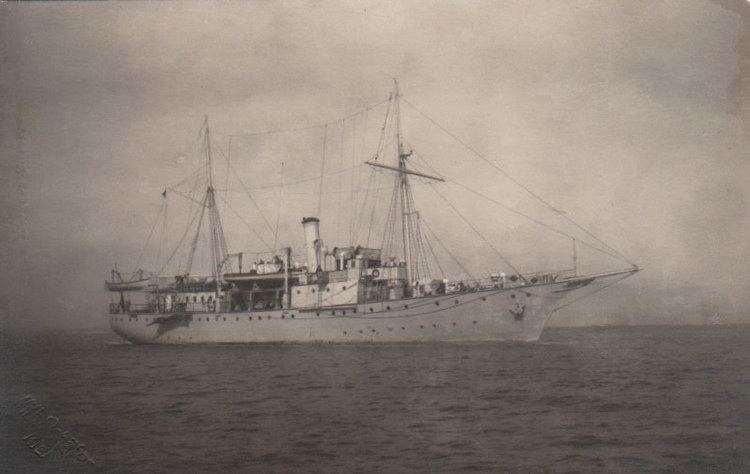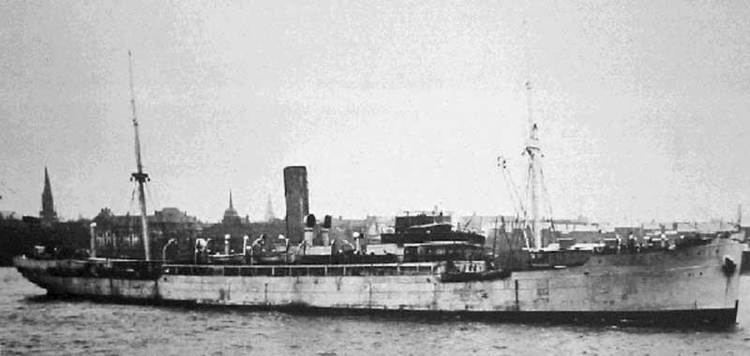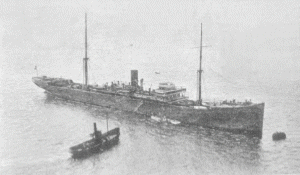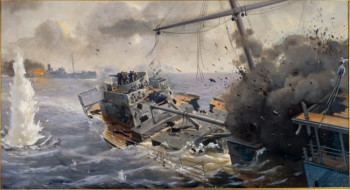Ordered Laeisz In service 1 November 1915 Launched 1914 Draft 7.2 m | Builder Tecklenburg Draught 7.2 m Length 124 m Beam 14 m | |
 | ||
Displacement 9,800 tons (4,788 gross register tons (GRT)) | ||
German navy be like you are a pirate german sms m we
SMS Möwe (German: Seagull) was a merchant raider of the Imperial German Navy which operated against Allied shipping during World War I.
Contents
- German navy be like you are a pirate german sms m we
- Early history
- First raiding voyage
- Interlude as Vineta
- Second raiding voyage
- Later history
- Raiding career
- Film
- References

Disguised as a neutral cargo ship to enable it to get close to targets, the Möwe was effective at commerce raiding, sinking several ships in the course of the war.

Early history
Built by the Tecklenborg yard at Geestemünde, she was launched as the freighter Pungo in 1914 and operated by the Afrikanische Fruchtkompanie for F. Laeisz of Hamburg. After an uneventful career carrying cargoes of bananas from the German colony of Kamerun to Germany she was requisitioned by the Imperial German Navy for use as a minelayer. Her conversion took place at Imperial shipyard at Wilhelmshaven in the autumn of 1915, and under the command of Nikolaus zu Dohna-Schlodien, she entered service on 1 November that year.
First raiding voyage

Möwe slipped out of Wilhelmshaven on 29 December 1915 for her first task, to set a minefield in the Pentland Firth, near the main base of the British Home Fleet at Scapa Flow. This was completed in severe weather conditions. A few days later the pre-dreadnought battleship HMS King Edward VII struck one of the mines; despite attempts to tow her to safety she sank. Möwe then moved down the west coast of Ireland to France. There she laid another mine field off the Gironde estuary, which sank a further two ships.

This part of her mission complete, Möwe then moved into the Atlantic, operating first between Spain and the Canary islands, and later off the coast of Brazil. On January 16, 1916, the Möwe encountered a lightly armed British merchant ship and after a small battle, the British ship was scuttled. In three months she caught fifteen ships, two of which were sent, with cargo and prisoners, to port as prizes; the rest were sunk. She returned to Germany, and a hero's welcome, on 4 April 1916. Richard Stumpf records that there were a number of Africans amongst the crew upon this arrival. Felix von Luckner served aboard SMS Möwe before his journey with SMS Seeadler in late 1916 to late 1917.
Interlude as Vineta
In an effort to maintain security, Möwe was renamed Vineta, after another auxiliary cruiser which had been withdrawn from service. In this guise she set out on a series of short cruises during the summer of 1916 to attack Allied shipping off the coast of Norway. This only brought one success, however, before she was ordered in for a refit prior to another sortie into the Atlantic.
Second raiding voyage
Departing on 23 November 1916, Möwe had even more success on her second cruise into the Atlantic.
On 6 December 1916, she captured and sank the Canadian Pacific Steamship freighter SS Mount Temple outbound from Halifax to Liverpool. Mount Temple′s cargo included 700 horses bound for the Canadian Expeditionary Force in France and many crates of dinosaur fossils collected from Alberta's Red Deer River badlands by Charles H. Sternberg destined for the British Museum of Natural History. On 12 December, it was the turn of SS Georgic, sunk along with her cargo of 1,200 horses that would have been used on the Western Front.
In four months she had accounted for another 25 ships totalling 123,265 GRT. One of these, SS Yarrowdale, was sent as prize to Germany and, as Dohna-Schlodien had recommended, was outfitted as a commerce raider herself. Möwe also retained SS Saint Theodore as a collier, before arming and commissioning her as the auxiliary Geier. Geier operated in this role for six weeks, accounting for two ships sunk, before being disarmed and scuttled by Möwe prior to returning home. On 10 March, she was damaged in action against an armed New Zealand merchant ship. Five of her crewmen were killed and another ten men were wounded. The damage forced the raider to return course for Germany. In March 1917 Möwe again successfully ran the British blockade, ironically at the same time as Yarrowdale, now the auxiliary cruiser SMS Leopard, was cornered and sunk by the same blockading force. Möwe arrived home safely on 22 March 1917.
Later history
On her return Möwe was taken out of service as a raider, being reckoned too valuable as a propaganda tool to be risked again. She served in the Baltic as a submarine tender, before becoming the auxiliary minelayer Ostsee in 1918. After the Treaty of Versailles, she went to Britain, to be operated by Elders and Fyffes as the freighter Greenbrier. In 1933 she was sold to a German shipping company. As the freighter Oldenburg, it served the route between Germany and occupied Norway in World War II.
On 7 April 1945 she was attacked by Bristol Beaufighters of Coastal Command on anti-shipping missions while sheltering off the coast of Norway—near the village of Vadheim in Sogn og Fjordane county. Holed by their rockets and strafed by cannon fire, she burned and sank.
Raiding career
In three raiding voyages Möwe captured and sank 40 ships, grossing in excess of 180,000 GRT. She also laid mines which accounted for two more ships and a capital warship. This made her the most successful German raider in either the First or the Second World War.
Film
In 1917 the imperial Bild- und Filmamt in Berlin produced Graf Dohna und seine Möwe, one of the best-known propaganda films of World War I. The distributor was Paul Davidson; part of the production the Projektions-AG »Union« (PAGU), Berlin. The film was first released on 2 May 1917 in the Deutsches Opernhaus (Deutsche Oper Berlin) in Berlin.
